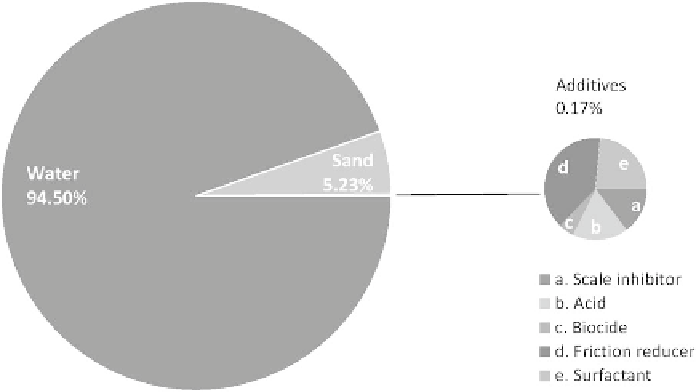Environmental Engineering Reference
In-Depth Information
Figure 4 An illustration of the composition of fracture fluid composition for shale
gas well hydraulic fracturing operations.
The fracturing fluid has to reach the bottom of the well, which may be
several kilometres below the surface, via a relatively narrow diameter (150-
200 mm) pipe as eciently as possible. The addition of friction reducers or
surfactants allows the fluids to be pumped to the target zone at a higher rate
and lower pressure. Examples of chemicals used as friction reducers are
methanol or ethylene glycol.
Acid is utilised in the beginning of the fracture process to clean-up cement
that is lodged in the well casing perforations and provide an accessible path
to the formation once fracturing fluid is pumped in. Hydrochloric acid is
most commonly used at concentrations ranging from 3 to 28%. In stimu-
lations that use acid, a corrosion inhibitor is also often used to hinder the
corrosion of steel tubing, well casing, tools and tanks. The addition of 0.1 to
2% of a corrosion inhibitor can decrease corrosion by up to 95%. Concen-
trations of corrosion inhibitor depend on down-hole temperatures and
casing and tubing types. At temperatures exceeding 130 1C, higher concen-
trations of corrosion inhibitor, a booster or an intensifier may also be
necessary. A typical corrosion inhibitor used in shale gas operations is
N,N-dimethyl formamide.
Biocides are additives that are used to minimise the danger of bacterial
corrosion in the wellbore.
15
Fracture fluids typically contain gels that are
organic. They can provide an ideal medium for bacterial growth, reducing
viscosity and the ability of the fluid to effectively deliver the proppant. Bio-
cides, such as glutaraldehyde are diluted in the fluid in a manner similar to
the addition of the corrosion inhibitor.
When a formation contains clay, permeability can be significantly reduced
when exposed to water that is less saline than the formation water. As a

